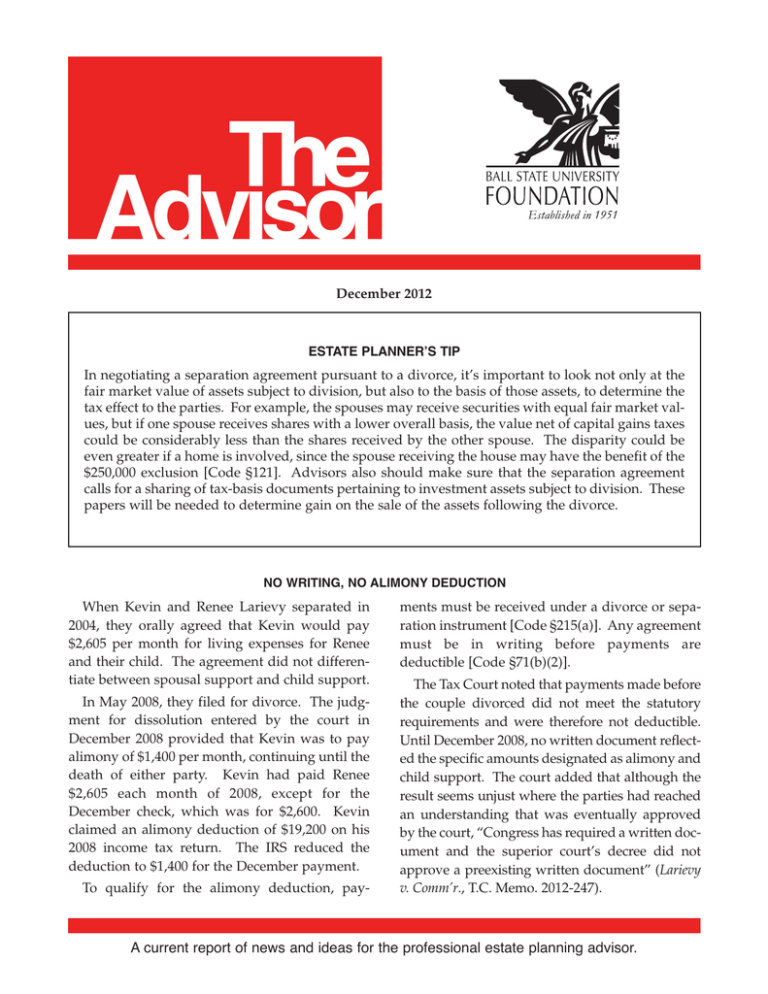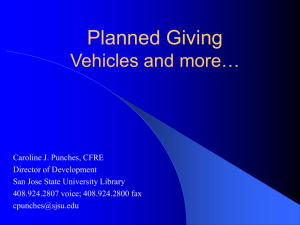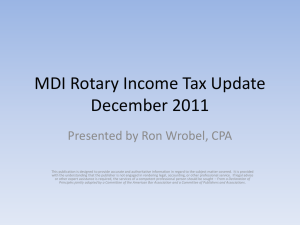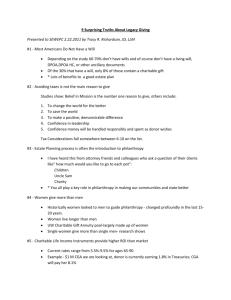The Advisor |
advertisement

The| Advisor December 2012 ESTATE PLANNER’S TIP In negotiating a separation agreement pursuant to a divorce, it’s important to look not only at the fair market value of assets subject to division, but also to the basis of those assets, to determine the tax effect to the parties. For example, the spouses may receive securities with equal fair market values, but if one spouse receives shares with a lower overall basis, the value net of capital gains taxes could be considerably less than the shares received by the other spouse. The disparity could be even greater if a home is involved, since the spouse receiving the house may have the benefit of the $250,000 exclusion [Code §121]. Advisors also should make sure that the separation agreement calls for a sharing of tax-basis documents pertaining to investment assets subject to division. These papers will be needed to determine gain on the sale of the assets following the divorce. NO WRITING, NO ALIMONY DEDUCTION When Kevin and Renee Larievy separated in 2004, they orally agreed that Kevin would pay $2,605 per month for living expenses for Renee and their child. The agreement did not differentiate between spousal support and child support. In May 2008, they filed for divorce. The judgment for dissolution entered by the court in December 2008 provided that Kevin was to pay alimony of $1,400 per month, continuing until the death of either party. Kevin had paid Renee $2,605 each month of 2008, except for the December check, which was for $2,600. Kevin claimed an alimony deduction of $19,200 on his 2008 income tax return. The IRS reduced the deduction to $1,400 for the December payment. To qualify for the alimony deduction, pay- ments must be received under a divorce or separation instrument [Code §215(a)]. Any agreement must be in writing before payments are deductible [Code §71(b)(2)]. The Tax Court noted that payments made before the couple divorced did not meet the statutory requirements and were therefore not deductible. Until December 2008, no written document reflected the specific amounts designated as alimony and child support. The court added that although the result seems unjust where the parties had reached an understanding that was eventually approved by the court, “Congress has required a written document and the superior court’s decree did not approve a preexisting written document” (Larievy v. Comm’r., T.C. Memo. 2012-247). A current report of news and ideas for the professional estate planning advisor. The Advisor OPPORTUNITY TO SAVE MORE Thanks to cost-of-living adjustments, employees will be able to save more for retirement next year. Those participating in 401(k) or 403(b) plans can contribute a maximum of $17,500 in 2013, up $500 from 2012. The catch-up contribution for those age 50 and older remains at $5,500 (IR-2012-77). SOME GET MORE, SOME PAY MORE The nearly 62 million Americans who receive Social Security benefits will be getting a raise in 2013. A 1.7% cost-of-living increase will boost the average monthly benefit for all retired workers from $1,240 to $1,261. The maximum benefit for a worker retiring at full retirement age increases from $2,513 per month to $2,533. The inflation increase also means that persons still working will pay in longer. The maximum taxable earnings for the old age, survivor and disability insurance portion will jump from $110,100 to $113,700. There is no earnings limit on the Medicare portion. Also increasing is the amount that Social Security recipients can earn before benefits are reduced. Beneficiaries who have not reached full retirement age can earn $15,120, compared with PHILANTHROPY PUZZLER Leon is the executor of his Uncle Ed’s estate. Ed, who gave generously to several charities, had made multi-year pledges to his college and the local hospital. At Ed’s death, both of the pledges still had payments outstanding. Leon would like to satisfy the balances but has asked whether the estate will be entitled to any charitable deductions. $14,640 in 2012, before benefits are reduced by $1 for every $2 in earnings over the limit. OH, JUST DISREGARD THAT COMPANY The IRS has determined that a single-member limited liability company (SMLLC) that is wholly owned and controlled by a U.S. charity is considered a disregarded entity under Code §301.77012(c)(2)(i). Generally, the activities of a disregarded entity “are treated in the same manner as a sole proprietorship, branch or division of the owner.” Charitable contributions to SMLLCs will be treated as gifts to a branch or division of the charity (Notice 2012-52). Note: This ruling may be particularly welcomed by charities wishing to remain out of the chain of title of gifts of environmentally questionable real estate. COBWEBS PROVE BENEFICIARY NOT DILIGENT Frank McDougal had expected an inheritance from his aunt’s trust that would have provided him with $600 to $700 per month following his mother’s death. Instead, at his aunt’s death in 1992, he learned that the residue of her estate would pass to a private foundation and that $350,000 would be used to fund a charitable remainder trust. McDougal’s mother was the income beneficiary of the trust, with six charities named as remaindermen. McDougal’s mother, who had possession of the aunt’s estate papers, took the documents to an attorney. The lawyer told McDougal that he had properly been removed as a beneficiary. In 2003, McDougal’s mother died and he was given boxes containing his aunt’s estate papers, although he did not review the contents. In 2009, McDougal went through the papers while cleaning out his attic. He took the trust to a handwriting expert who confirmed McDougal’s The Advisor suspicion that his aunt’s signature had been forged on the trust agreement creating the foundation in 1983. He filed suit for tortious interference with an expectancy of inheritance, claiming that his aunt’s attorney had exerted undue influence over his aunt and had physically forced her to sign the documents. As foundation trustee, the attorney’s firm received and continues to pay itself legal fees from the trust. The trial court granted the foundation’s motion for summary judgment, finding that McDougal’s action was barred by the four-year statute of limitation. McDougal argued that the clock should have started in 2009, when he discovered the forgery. The Court of Appeals of Ohio noted that the limitation period begins running when McDougal “has discovered, or should have discovered in the exercise of reasonable diligence, the alleged fraud.” McDougal never requested to see the documents when the will was probated, took physical possession of them in 2003, and did not review them until 2009. This “was not reasonable diligence” on his part, ruled the appeals court, upholding the trial court’s summary judgment (McDougal v. Vecchio, 2012 Ohio 4287). “the entire agreement of the parties,” and the acknowledgment letter stated that no goods or services were provided in exchange for the easement. The Tax Court found that the agreement, “taken as a whole,” states that no goods or services were received and satisfies the substantiation requirements. The IRS’s motion for summary judgment on that matter was denied. However, the Missouri conservation policy cited in the agreement between the parties is limited to open spaces within counties with a population of more than 200,000, or in any adjoining county, or any city not within but adjoining such a county. The court found no evidence that Platte County met the population requirement. Therefore, because the easement was not made pursuant to a governmental conservation policy, the conservation purpose of the easement would rest on whether it protects “a relatively natural habitat of fish, wildlife, or plants, or similar ecosystem” under Code §170(h)(4)(A)(ii). The court denied the IRS’s motion for summary judgment on that question, saying it continues to be in dispute (RP Golf, LLC v. Comm’r., T.C. Memo. 2012-282). SUBSTANTIATION OKAY, CONSERVATION PURPOSE STILL QUESTIONABLE RP Golf, LLC, is a partnership that owns two private golf courses on 277 acres of land in Missouri. The partnership granted a conservation easement over the land to the Platte County Land Trust. The IRS disallowed Golf’s $16,400,000 charitable deduction on the grounds that the substantiation requirements of Code §170(f)(8) had not been met and that the easement does not preserve open space pursuant to a clearly delineated state or local government conservation policy [Code §170(h)(4)(A)(iii)(II)]. The transfer document between Golf and the Trust indicated that the instrument represented PUZZLER SOLUTION Charitable pledges are not tax deductible until they have been satisfied [Rev. Rul. 68174, 1968-1 CB 81]. If Ed’s will is silent as to whether outstanding pledge amounts are to be paid from his estate, the deductibility of the payments will depend upon whether they are considered an obligation under state law. If so, the pledge is considered a claim against the estate and is deductible under Code §2053, not a charitable bequest under Code §2055. The Advisor TIMELY IDEAS BEFORE RINGING IN THE NEW YEAR Before getting out the party hats and confetti, clients should consider how charitable gifts made before year’s end will brighten next year’s tax filing season. For many clients, making charitable gifts is a part of their year-end tax planning, but it’s important to keep a few facts in mind: n A check mailed to charity by December 31 is deductible this year, even though the organization doesn’t receive or cash the check until early 2013 [Reg. §1.170A-1(b)]. If the donor is short of cash or simply wants to accumulate frequent flier miles, a charitable gift can be charged on a credit card before January 1. The gift is deductible on the 2012 return [Rev. Rul. 78-38, 1978-1 CB 67]. A pledge, however, is deductible only when paid [Rev. Rul. 68-174, 1968-1 CB 81]. n Donors who contribute cash can claim deductions up to 50% of adjusted gross income [Code §170(b)(1)(A)]. A gift of stock or other appreciated property held more than one year is deductible up to 30% of AGI [Code §170(b)(1)(C)(i)]. In either case, excess deductions may be carried over for up to five years [Code §170(b)(1)(B)]. n C corporations may claim charitable deductions up to 10% of taxable income [Code §170(b)(2)]. An S corporation is not allowed a charitable deduction. Instead, the deductions flow through to the shareholders, according to their respective ownership interests, and are deducted on their personal returns [Code §§1366(a), 702(a)(4)]. n A donor who makes a cash gift of $250 or more must obtain a contemporaneous written substantiation from the charity prior to the earlier of the due date of the return or the date the David W. Bahlmann, J.D. President/CEO return on which the deduction is claimed is filed [Code §170(f)(8)]. A donor who contributes a noncash gift may need a qualified appraisal to substantiate the value [Reg. §1.170A-13(c)]. Generally, an appraisal is needed when the donor claims a deduction of $5,000 or more ($10,000 for closely held stock). Appraisals are not required for gifts of publicly traded stock for which a market quotation is readily available. n A gift of appreciated property held more than one year can save more taxes than a gift of cash. The donor avoids the capital gains tax that would have been due had the asset been sold, in addition to earning a charitable deduction equal to the fair market value of the property. If the asset has gone down in value, the donor should sell first – locking in a capital loss deduction – and contribute the sale proceeds, generating a charitable deduction. If the appreciated property has been held one year or less, the donor’s deduction is limited to the lesser of fair market value or basis [Code §170(e)(1)(A)]. A transfer of appreciated stock held in a brokerage account is complete when the stock is posted to the charity’s account, not when the direction is given to the broker. n Donors who wish to make a gift this year and earn a deduction, but who can’t part with the income, should consider a gift that reserves income for life. A donor could fund a charitable remainder unitrust prior to year’s end and receive a charitable deduction while reserving income for life from the trust. Deductions would be available in future years for additions to the unitrust. Donors could also arrange charitable gift annuities, retaining payments from charity for their lives. BALL STATE UNIVERSITY FOUNDATION P.O. Box 672, Muncie, IN 47308 (765) 285-8312 • (765) 285-7060 FAX Toll Free (888) 235-0058 www.bsu.edu/bsufoundation Philip M. Purcell, J.D. Vice President for Planned Giving and Endowment Stewardship If you know another professional advisor who would benefit from this publication, please contact The Foundation.







